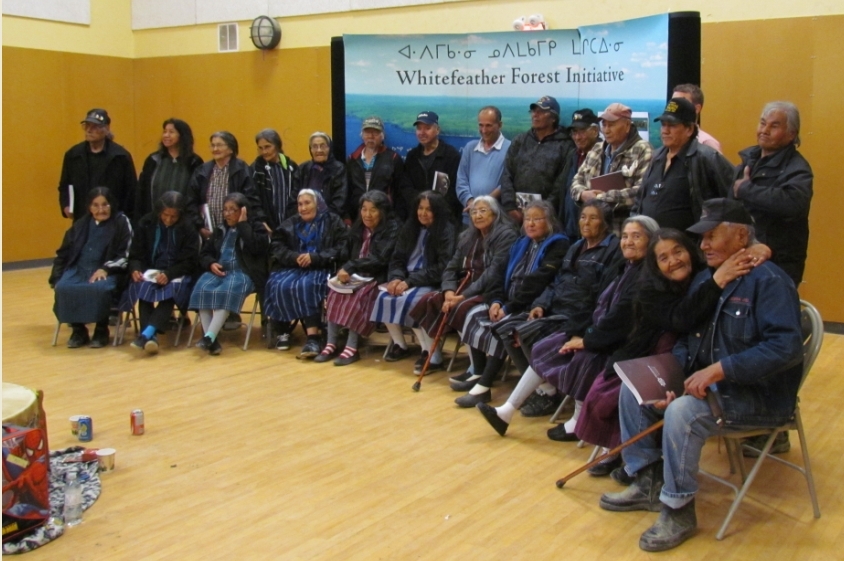Pikangikum is looking forward to new economic development opportunities in the Whitefeather Forest after being issued a provincial sustainable forest licence on May 29.
“Our Elders are elated with the issuance of the SFL for the Whitefeather Forest,” said Alex Peters, president of the Whitefeather Forest Community Resource Management Authority. “At times we wondered how we would make it. But we have. It was the encouragement of the Elders and their vision of creating new economic opportunities for our youth and for future generations that kept us going. The need to create new opportunities has only grown more urgent since we began. Now we can move forward into beginning our enterprise operations.”
Peters said the community developed its forest management plan for the Whitefeather Forest in 2012. Located about 80 kilometres east of the Manitoba border, 90 kilometres north of Red Lake and 400 kilometres northwest of Thunder Bay, the Whitefeather Forest covers about 11,749 square kilometres.
“It was endorsed by the MNR (Ministry of Natural Resources) and endorsed by the community in 2012,” Peters said. “And we have a few companies that we are talking to.”
Peters said the process was initiated by the community’s Elders after the fur harvesting and commercial fishing industries collapsed in the late 1980s, noting the Elders realized “there was money in them there trees.”
“When this was first started by the Elders, they said we are not only looking at the present day, this is for our children, our grandchildren and future generations,” Peters said. “We have five forestry technicians that are going to graduate in August from our community. We have foresters that have been in the business for 30 years working for us. There are a lot of people out there, retired foresters, that are willing to help.”
While the Elders encouraged the community to cherish their traditional lands and all the living beings on those lands by continuing to follow their responsibilities of Keeping the Land — Cheekahnahwaydahmunk Keetahkeemeenahn, they also noted the gifts were meant to be used for their survival and livelihood.
“Keeping the land means to receive a gift, our livelihood, the way we have lived on the land,” said Elder Ellen Peters. “The land helped us to be very active. I remember one day we were cutting firewood and I was looking at the trees. I just looked at those trees; every tree was created differently, so beautiful. Each one was created in its own unique way. This is why we were taught to keep the land, why we started this initiative. Let’s hold onto these gifts from the Creator. We have been richly blessed; especially the land where everything that we have been blessed with is found.”
Accordingly, the Elders gave the community the mandate to pursue forest development opportunities in 1996. Some had previously worked in sawmills in the Red Lake area and others had seen forest companies harvesting wood north of Red Lake.
“They decided that we had excellent timber on our lands and that this was an opportunity,” said Peter Quill, economic development officer at the time. “When I was travelling once with Paddy Peters to Red Lake during this time, we could see non-natives were developing forestry opportunities and gaining the benefits. Forestry was already taking place in our lands north of Red Lake.”
Pikangikum’s sustainable forest licence is the first granted by the provincial government to a First Nations community in the Far North.
“We are pleased to work with Pikangikum First Nation so the community can undertake forest management activities in the Whitefeather Forest,” said David Orazietti, minister of Natural Resources. “Issuing the sustainable forest licence is an important step in implementing Pikangikum’s community-based land use strategy and is a positive outcome of land use planning in the Far North. It will allow Pikangikum to influence its own economic destiny and guide forestry in the area to bring jobs and opportunity to the community.”
David Zimmer, minister of Aboriginal Affairs, said the issuing of the sustainable forest licence is one of the ways Ontario and First Nation communities are forging lasting partnerships.
“Working together on priority areas, we’re creating economic development opportunities and helping build stronger, healthier communities, both now and in the future,” Zimmer said.
Pikangikum Chief Dean Owen said the sustainable forest licence will allow the community to move forward economically with a forestry opportunity.
“I wish to thank our Elders, the rest of the Whitefeather Forest Initiative Team, the MNR staff who have worked with us over the years, and all of our other partners for their dedication and commitment in working with us to reach this major milestone,” Owen said.
Gold has arrived.












Gold has arrived. Here in the north of Ontario we see vast streams of gold shimmering across the landscape as autumn is here and the the leaves are turning...
I am the product, evolution of many thousands of years as are you. I grew up on the land in the remote far north of Ontario following in the footsteps of my...